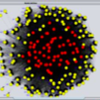Geo-social visual analytics
Keywords:
geography, social network, visual analytics, First Law of Geography, data exploration, decision-making, predictive analysisAbstract
Spatial analysis and social network analysis typically consider social processes in their own specific contexts, either geographical or network space. Both approaches demonstrate strong conceptual overlaps. For example, actors close to each other tend to have greater similarity than those far apart; this phenomenon has different labels in geography (spatial autocorrelation) and in network science (homophily). In spite of those conceptual and observed overlaps, the integration of geography and social network context has not received the attention needed in order to develop a comprehensive understanding of their interaction or their impact on outcomes of interest, such as population health behaviors, information dissemination, or human behavior in a crisis. In order to address this gap, this paper discusses the integration of geographic with social network perspectives applied to understanding social processes in place from two levels: the theoretical level and the methodological level. At the theoretical level, this paper argues that the concepts of nearness and relationship in terms of a possible extension of the First Law of Geography are a matter of both geographical and social network distance, relationship, and interaction. At the methodological level, the integration of geography and social network contexts are framed within a new interdisciplinary field:~visual analytics, in which three major application-oriented subfields (data exploration, decision-making, and predictive analysis) are used to organize discussion. In each subfield, this paper presents a theoretical framework first, and then reviews what has been achieved regarding geo-social visual analytics in order to identify potential future research.

Downloads
Published
Issue
Section
License
Copyright (c) 2014 Wei Luo, Alan M. MacEachren

This work is licensed under a Creative Commons Attribution 4.0 International License.
Articles in JOSIS are licensed under a Creative Commons Attribution 3.0 License.
